Another very small range day makes a very slight new high but closes red. Price is moving sideways, which is what the Elliott wave count expected for the short term.
Summary: The next target is now at 3,238 to 3,240, but this may be too high. About this target a fourth wave correction may begin which should last about two weeks and end somewhere within the range of 3,154.26 to 3,070.49.
Thereafter, the next target is at 3,302 for a larger fourth wave correction and then 3,336 for an even larger fourth wave correction.
Three large pullbacks or consolidations (fourth waves) during the next 1-2 years are expected: for minor wave 4 (coming soon), then intermediate (4), and then primary 4. Some weakness prior to each of these corrections may be evident in technical analysis. Today there is no weakness.
The biggest picture, Grand Super Cycle analysis, is here.
Monthly charts were last published here, with video here. There are two further alternate monthly charts here, with video here.
ELLIOTT WAVE COUNTS
The two weekly Elliott wave counts below will be labelled First and Second. They may be about of even probability. When the fifth wave currently unfolding on weekly charts may be complete, then these two wave counts will diverge on the severity of the expected following bear market. To see an illustration of this future divergence monthly charts should be viewed.
FIRST WAVE COUNT
WEEKLY CHART
The basic Elliott wave structure consists of a five wave structure up followed by a three wave structure down (for a bull market). This wave count sees the bull market beginning in March 2009 as an incomplete five wave impulse and now within the last fifth wave, which is labelled cycle wave V. This impulse is best viewed on monthly charts. The weekly chart focusses on the end of it.
Elliott wave is fractal. This fifth wave labelled cycle wave V may end a larger fifth wave labelled Super Cycle wave (V), which may end a larger first wave labelled Grand Super Cycle wave I.
The teal Elliott channel is drawn using Elliott’s first technique about the impulse of Super Cycle wave (V). Draw the first trend line from the end of cycle wave I (off to the left of the chart, the weekly candlestick beginning 30th November 2014) to the end of cycle wave III, then place a parallel copy on the end of cycle wave II. This channel perfectly shows where cycle wave IV ended at support. The strongest portion of cycle wave III, the end of primary wave 3, overshoots the upper edge of the channel. This is a typical look for a third wave and suggests the channel is drawn correctly and the way the impulse is counted is correct.
Within Super Cycle wave (V), cycle wave III is shorter than cycle wave I. A core Elliott wave rule states that a third wave may never be the shortest. For this rule to be met in this instance, cycle wave V may not be longer in length than cycle wave III. This limit is at 3,477.39.
Cycle wave V may subdivide either as an impulse or an ending diagonal. Impulses are much more common. An alternative wave count which considered an ending diagonal has been invalidated. While it is possible a diagonal may become an alternate wave count in coming weeks or months, at this stage the structure does not fit.
At this stage, cycle wave V may take another one to two or so years to complete.
The daily chart below will focus on movement from the end of intermediate wave (2) within primary wave 3.
In historic analysis, two further monthly charts have been published that do not have a limit to upwards movement and are more bullish than this wave count. Members are encouraged to consider those possibilities (links below summary) alongside the wave counts presented on a daily and weekly basis. It is my judgement that the two weekly wave counts published in this analysis have the highest probability, so they shall be the only wave counts published on a daily basis.
Within cycle wave V, primary waves 1 and 2 may be complete. Within primary wave 3, intermediate waves (1) and (2) may be complete. Within the middle of intermediate wave (3), no second wave correction may move beyond its start below 2,855.96.
DAILY CHART
All of primary wave 3, intermediate wave (3) and minor wave 3 may only subdivide as impulses.
Minor wave 3 has passed 1.618 the length of minor wave 1, and within it minute wave v has passed equality in length with minute wave i. The next target may be about 3,238 where minute wave v would reach 1.618 the length of minute wave i, but this target may be too high.
At this stage, the structure of minute wave v within minor wave 3 still looks incomplete and needs to move higher.
Minor wave 2 was a sharp deep pullback, so minor wave 4 may be expected to be a very shallow sideways consolidation to exhibit alternation. Minor wave 2 lasted 2 weeks. Minor wave 4 may be about the same duration, or it may be a longer lasting consolidation. Minor wave 4 may end within the price territory of the fourth wave of one lesser degree; minute wave iv has its range from 3,154.26 to 3,070.49.
Minor wave 4 may not move into minor wave 1 price territory below 3,021.99.
Intermediate wave (3) must move far enough above the end of intermediate wave (1) to then allow intermediate wave (4) to unfold and remain above intermediate wave (1) price territory. While intermediate wave (3) has now moved beyond the end of intermediate wave (1), meeting a core Elliott wave rule, it still needs to continue higher to give room for intermediate wave (4).
The target for intermediate wave (3) fits with a target calculated for minor wave 3.
Draw an acceleration channel now about intermediate wave (3): draw the first trend line from the end of minor wave 1 to the last high, then place a parallel copy on the end of minor wave 2. Keep redrawing the channel as price continues higher. When minor wave 3 is complete, then this channel would be an Elliott channel and may show where minor wave 4 may find support if it is long lasting enough.
HOURLY CHART
The hourly chart will now focus on minute wave v.
Minute wave v is subdividing as an impulse. The structure may still be incomplete.
Within minute wave v, subminuette wave iv may not move into subminuette wave i price territory below 3,150.60. Thereafter, minuette wave (iv) may not move into minuette wave (i) price territory below 3,118.02.
Subminuette wave iv may complete quickly, or it may last one or two sessions to show up on the daily chart. Subminuette wave ii lasted 14 hours and shows up on the daily chart as a pullback lasting two sessions; it was a relatively deep 0.52 zigzag. Subminuette wave iv may exhibit alternation as a more shallow and time consuming sideways combination, flat or triangle. Today subminuette wave iv is labelled as a possible flat correction that may complete tomorrow with a new low slightly below 3,191.03, so that micro wave C avoids a truncation. So far subminuette wave iv has lasted 15 hours; if it completes tomorrow, then there would be very good proportion between subminuette waves ii and iv.
If this analysis is wrong in the short term, expect any surprises to be to the upside.
Draw a best fit channel about minute wave v. Expect support and resistance using this channel. If the channel is breached by downwards movement, then that may be an indication that minute wave v is over and minor wave 4 may have arrived. If the channel is breached, then use the alternate hourly chart below.
ALTERNATE HOURLY CHART
Price has been churning sideways now for two sessions on high volume. This looks like distribution and may be followed by a pullback. If that is correct, then this wave count may be an explanation in Elliott wave terms.
It is possible that minor wave 3 could be over at today’s high. However, this wave count suffers from a problem within the middle of minute wave v. Subminuette wave iii within minuette wave (iii) within minute wave v does not subdivide well at all as an impulse on the hourly chart time frame. Within the middle of the third wave, micro wave 4 is not visible on this time frame and must be assumed. It is possible to see an impulse for subminuette wave iii on the five minute time frame, but it suffers from gross disproportion between micro waves 2 and 4.
Targets for a consolidation or pullback for minor wave 4 may be the 0.146 or 0.236 Fibonacci ratios. Both sit within the price range of the fourth wave of one lesser degree; minute wave iv has its range from 3,154.26 to 3,070.89.
SECOND WAVE COUNT
WEEKLY CHART
This weekly chart is almost identical to the first weekly chart, with the sole exception being the degree of labelling.
This weekly chart moves the degree of labelling for the impulse beginning in March 2009 all down one degree. This difference is best viewed on monthly charts.
The impulse is still viewed as nearing an end; a fifth wave is still seen as needing to complete higher. This wave count labels it primary wave 5. Primary wave 5 may still need another year to two or so to complete, depending upon how time consuming the corrections within it may be.
Primary wave 5 may be subdividing as an impulse, in the same way that cycle wave V is seen for the first weekly chart.
TECHNICAL ANALYSIS
MONTHLY CHART
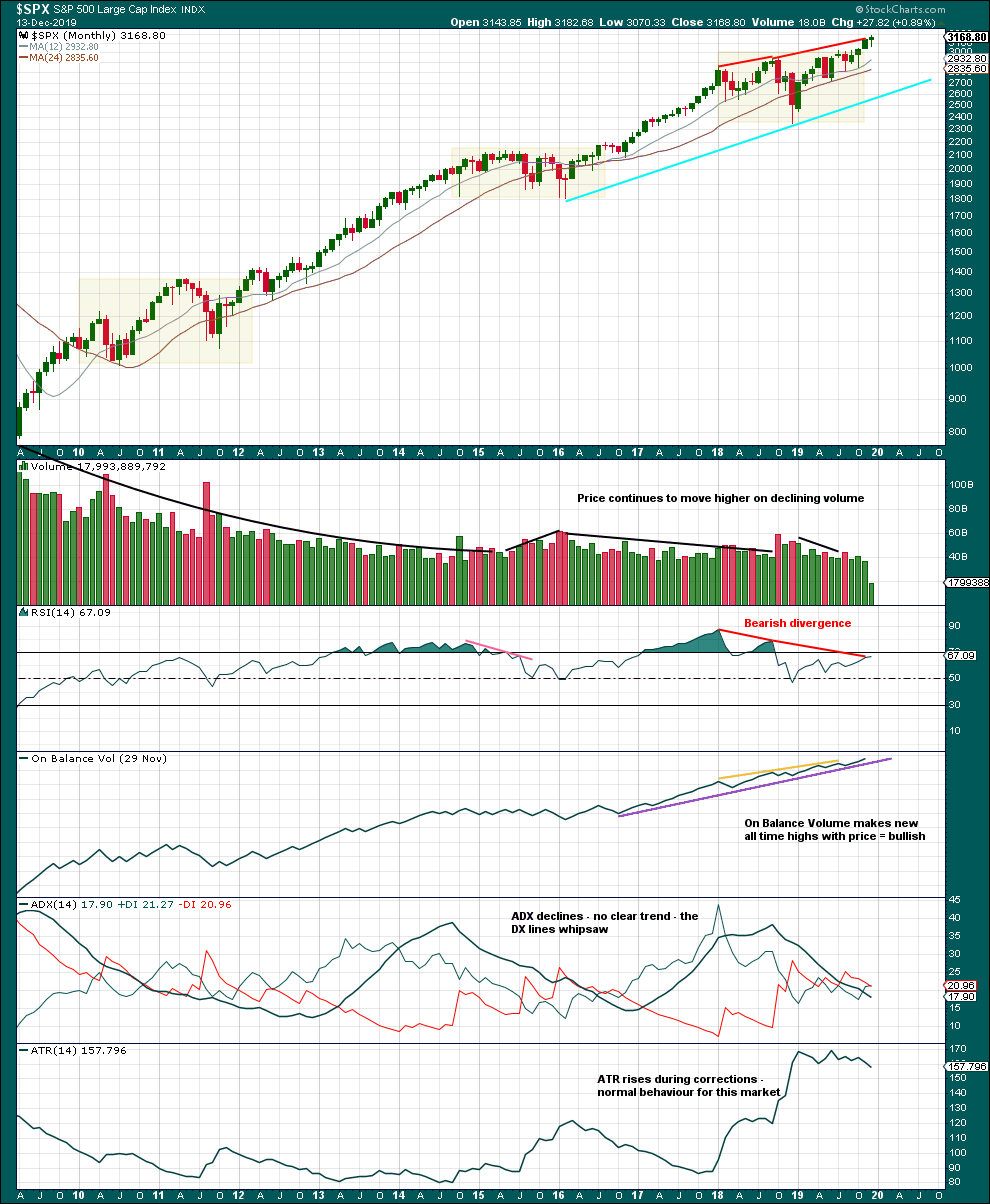
Click chart to enlarge. Chart courtesy of StockCharts.com.
There are three large consolidations noted on this chart, in shaded areas. After a breakout from a multi-month consolidation, it is reasonable to expect a multi month bullish move may result.
This chart very clearly exhibits rising price on declining volume has now persisted for several years. A decline in volume last month, in current market conditions, is not of concern.
On Balance Volume supports the Elliott wave count.
WEEKLY CHART
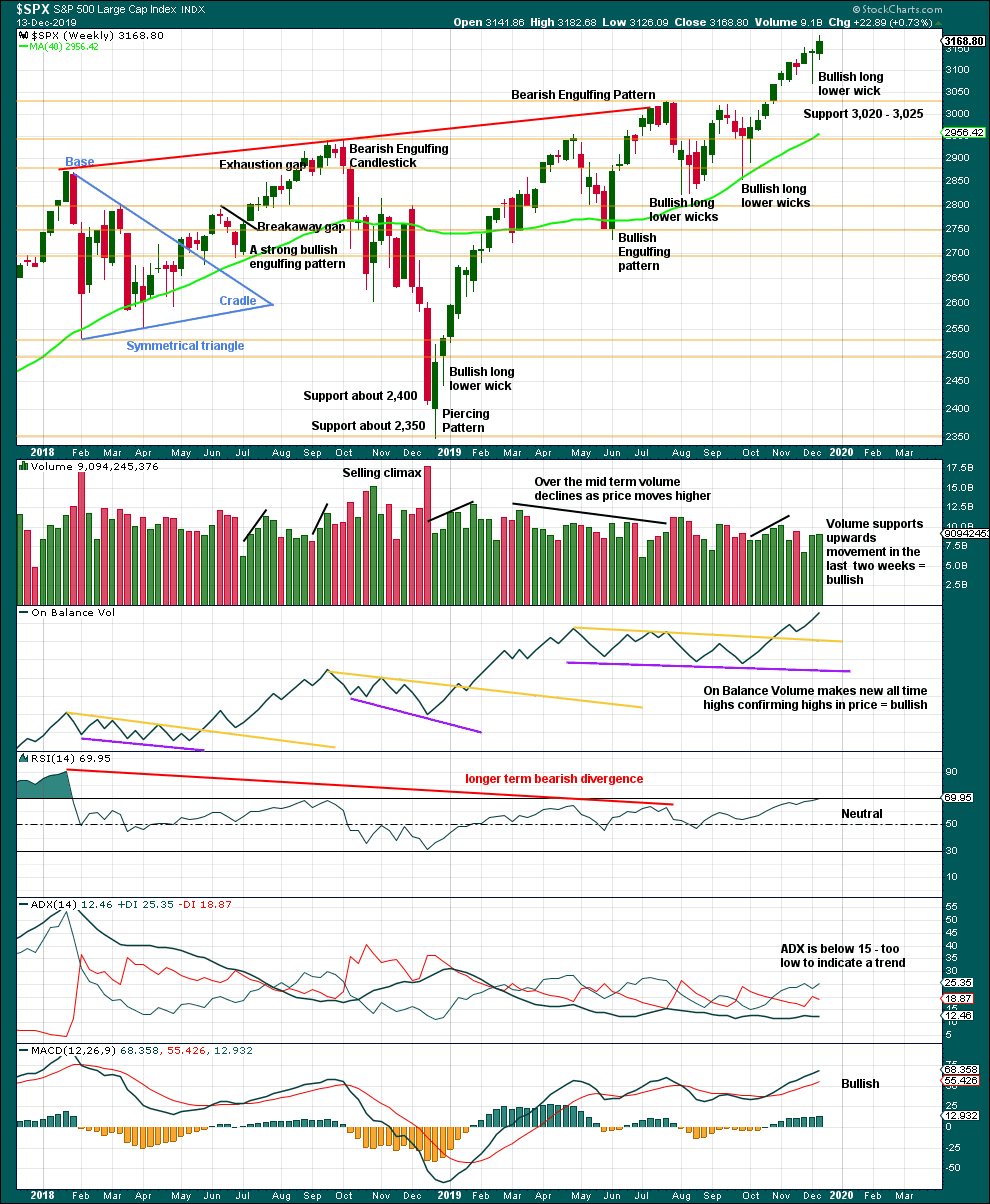
Click chart to enlarge. Chart courtesy of StockCharts.com.
It is very clear that the S&P is in an upwards trend and the bull market is continuing. Price does not move in straight lines; there will be pullbacks and consolidations along the way.
This chart is overall bullish. There are no signs of weakness in upwards movement.
DAILY CHART

Click chart to enlarge. Chart courtesy of StockCharts.com.
There is an upwards trend in place. There will be corrections along the way.
Like the weekly chart, this chart is bullish. The only sign of weakness is divergence between price and RSI. This divergence is weakened. Occasionally, divergence between price and RSI develops and then disappears and is not followed immediately by a pullback. That could happen here, or the divergence may develop further to indicate a pullback to arrive.
The last gap is labelled a measuring gap, which it will be as long as it remains open. If it is closed, then it would be relabelled an exhaustion gap. This gap gives a target at 3,240 that is very close to the Elliott wave target at 3,238.
When this market trends, Stochastics may remain overbought for a very long time. Stochastics should be used to identify swings within a consolidation and not extremes of bull and bear trends.
Today price has moved higher with a higher high and a higher low, but the candlestick is red and the balance of volume is down. Volume remains heavy and range is very small. This sideways churn of the last two sessions looks like distribution and may be followed by a pullback. With the larger trend remaining upwards, expect any pullbacks or consolidations to be short term in nature.
BREADTH – AD LINE
WEEKLY CHART
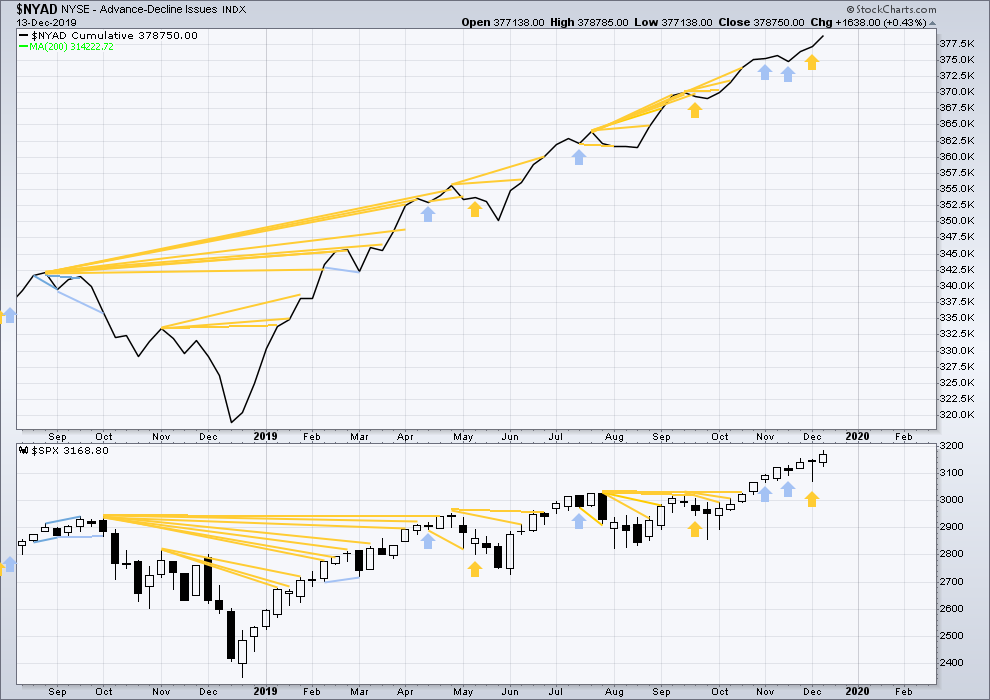
Click chart to enlarge. Chart courtesy of StockCharts.com. So that colour blind members are included, bearish signals
will be noted with blue and bullish signals with yellow.
Bear markets from the Great Depression and onwards have been preceded by an average minimum of 4 months divergence between price and the AD line with only two exceptions in 1946 and 1976. With the AD line making new all time highs last week, the end of this bull market and the start of a new bear market is very likely a minimum of 4 months away, which is mid March 2020.
In all bear markets in the last 90 years there is some positive correlation (0.6022) between the length of bearish divergence and the depth of the following bear market. No to little divergence is correlated with more shallow bear markets. Longer divergence is correlated with deeper bear markets.
If a bear market does develop here, it comes after no bearish divergence. It would therefore more likely be shallow.
All of small, mid and large caps have made new swing highs above the prior swing high on the 13th of September, but only large caps have made new all time highs. This upwards movement appears to be mostly driven by large caps, which is a feature of aged bull markets. This bull market at over 10 years duration certainly fits the definition of aged.
Last week both price and the AD line have made new all time highs. There is no divergence. Upwards movement has support from rising market breadth.
DAILY CHART
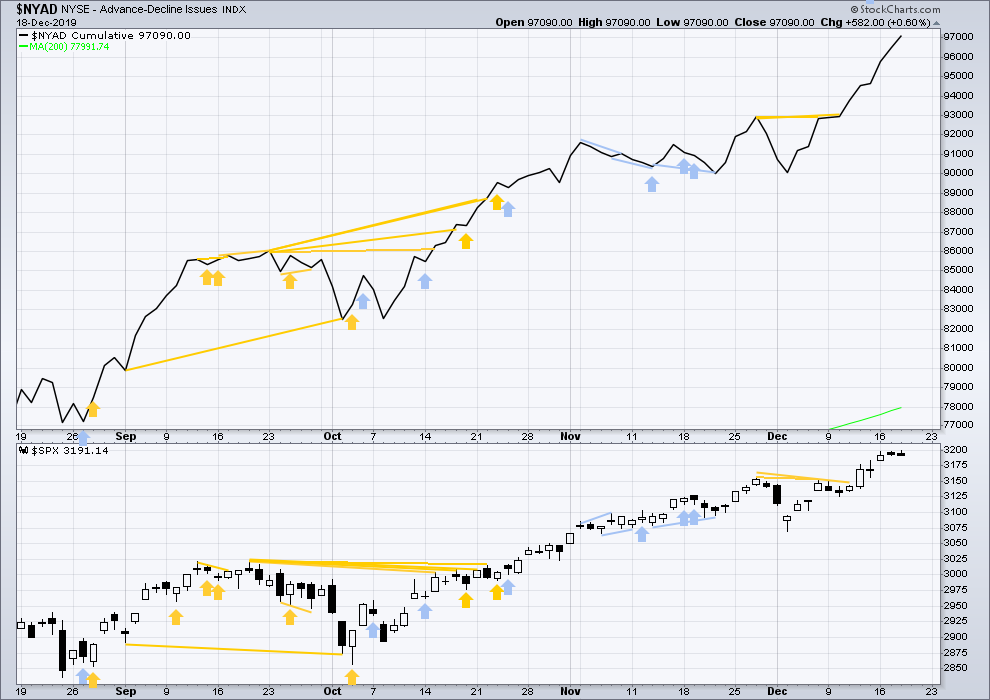
Click chart to enlarge. Chart courtesy of StockCharts.com. So that colour blind members are included, bearish signals
will be noted with blue and bullish signals with yellow.
Breadth should be read as a leading indicator.
On Friday price has moved higher but failed by a very small margin to make a new all time high. The AD line has moved higher to make a new all time high but only by a very small margin. This divergence is bullish, but it is weak.
Today again both price and the AD line have moved higher. Upwards movement has support from rising market breadth. This is bullish.
VOLATILITY – INVERTED VIX CHART
WEEKLY CHART
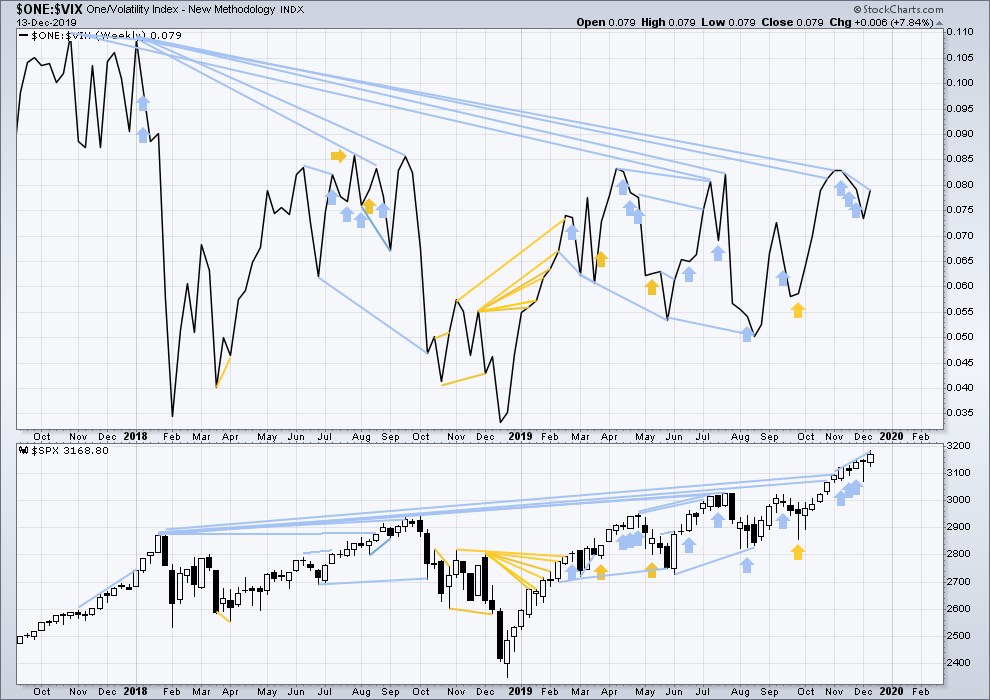
Click chart to enlarge. Chart courtesy of StockCharts.com. So that colour blind members are included, bearish signals
will be noted with blue and bullish signals with yellow.
The all time high for inverted VIX was on 30th October 2017. There is now over two years of bearish divergence between price and inverted VIX.
The rise in price is not coming with a normal corresponding decline in VIX; VIX remains elevated. This long-term divergence is bearish and may yet develop further as the bull market matures.
This divergence may be an early warning, a part of the process of a top developing that may take years. It may is clearly not useful in timing a trend change from bull to a fully fledged bear market.
Last week price has made new all time highs, but inverted VIX has not made new short, mid or long-term highs. Price has made a new high above the prior high four weeks ago, but inverted VIX has not. This divergence is bearish.
DAILY CHART
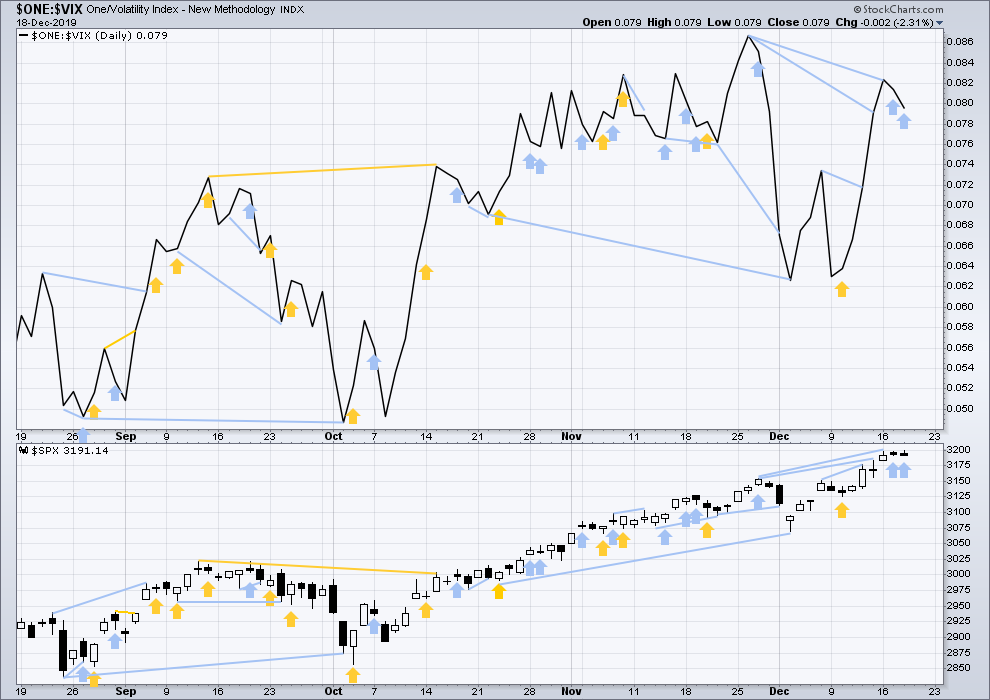
Click chart to enlarge. Chart courtesy of StockCharts.com. So that colour blind members are included, bearish signals
will be noted with blue and bullish signals with yellow.
Today price has again moved higher, but inverted VIX has moved lower. This divergence is bearish for the short term. Mid and long-term bearish divergence also remains.
DOW THEORY
Dow Theory confirmed a bear market in December 2018. This does not necessarily mean a bear market at Grand Super Cycle degree though; Dow Theory makes no comment on Elliott wave counts. On the 25th of August 2015 Dow Theory also confirmed a bear market. The Elliott wave count sees that as part of cycle wave II. After Dow Theory confirmation of a bear market in August 2015, price went on to make new all time highs and the bull market continued.
DJIA: 23,344.52 – a close on the 19th of December at 23,284.97 confirms a bear market.
DJT: 9,806.79 – price has closed below this point on the 13th of December.
S&P500: 2,532.69 – a close on the 19th of December at 2,506.96 provides support to a bear market conclusion.
Nasdaq: 6,630.67 – a close on the 19th of December at 6,618.86 provides support to a bear market conclusion.
With all the indices having moved higher following a Dow Theory bear market confirmation, Dow Theory would confirm a bull market if the following highs are made:
DJIA: 26,951.81 – a close above this point has been made on the 3rd of July 2019.
DJT: 11,623.58 – to date DJT has failed to confirm an ongoing bull market.
S&P500: 2,940.91 – a close above this point was made on the 29th of April 2019.
Nasdaq: 8,133.30 – a close above this point was made on the 26th of April 2019.
Published @ 07:56 p.m. EST.
—
Careful risk management protects your trading account(s).
Follow my two Golden Rules:
1. Always trade with stops.
2. Risk only 1-5% of equity on any one trade.
—
New updates to this analysis are in bold.


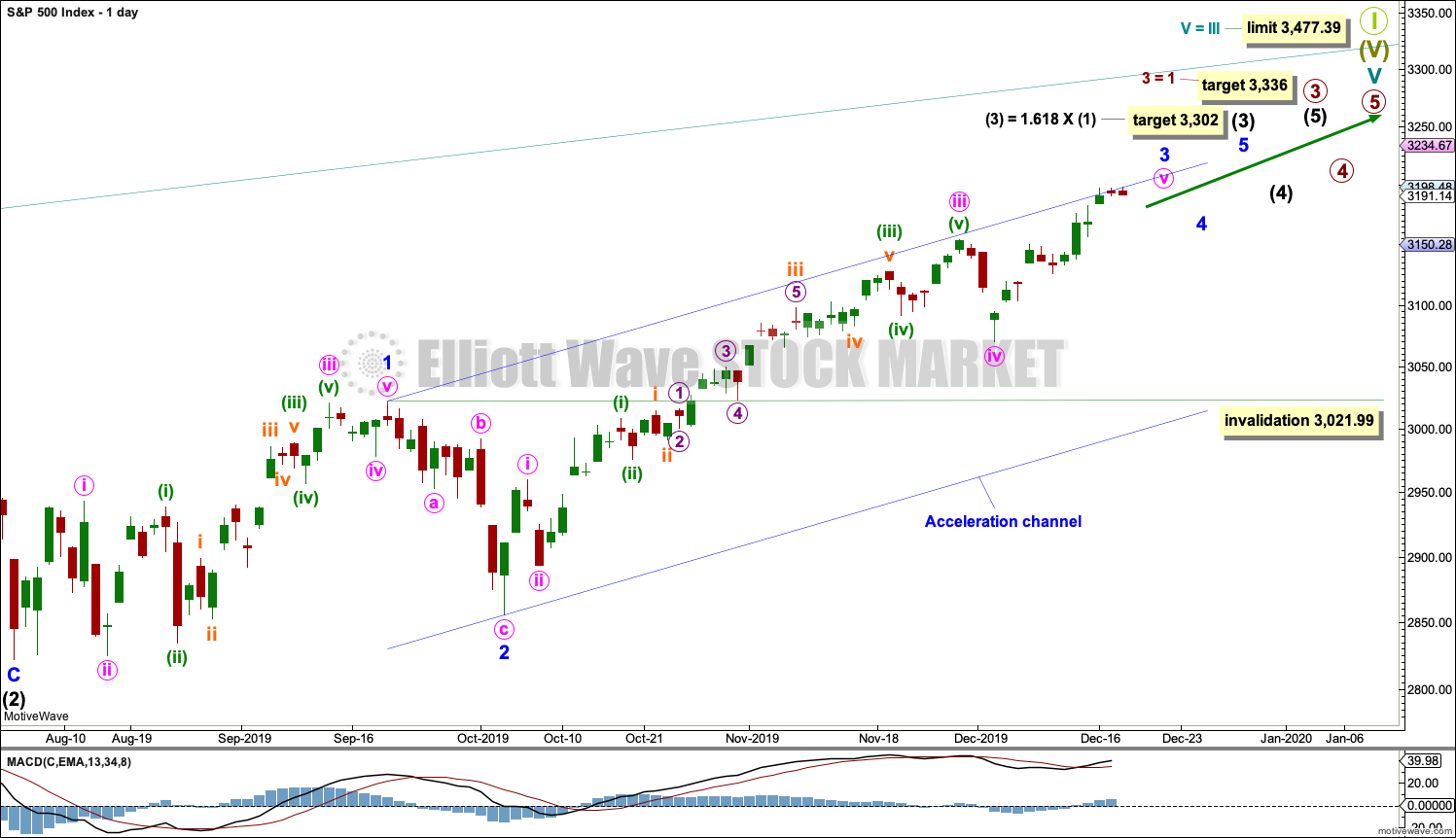
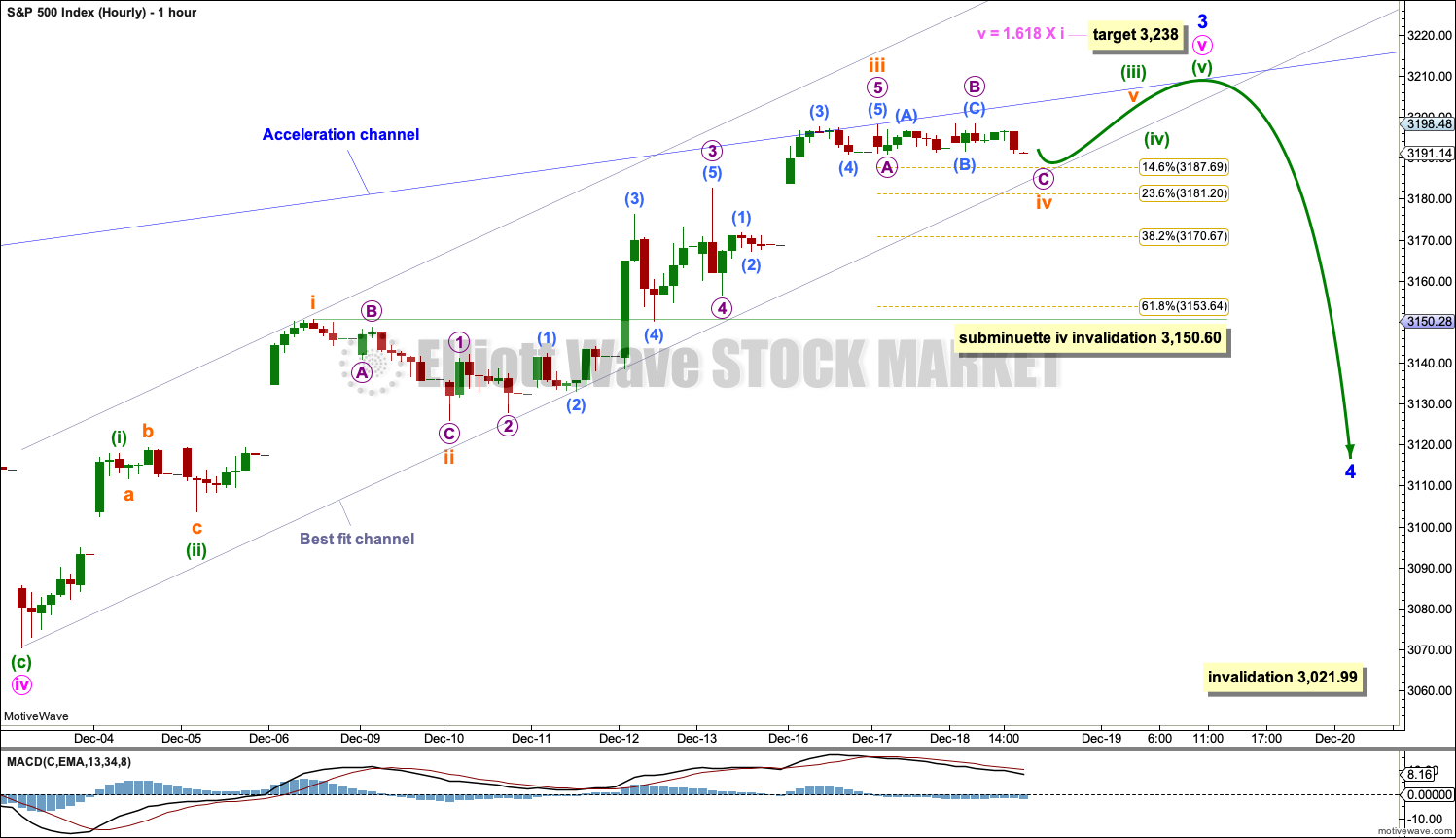
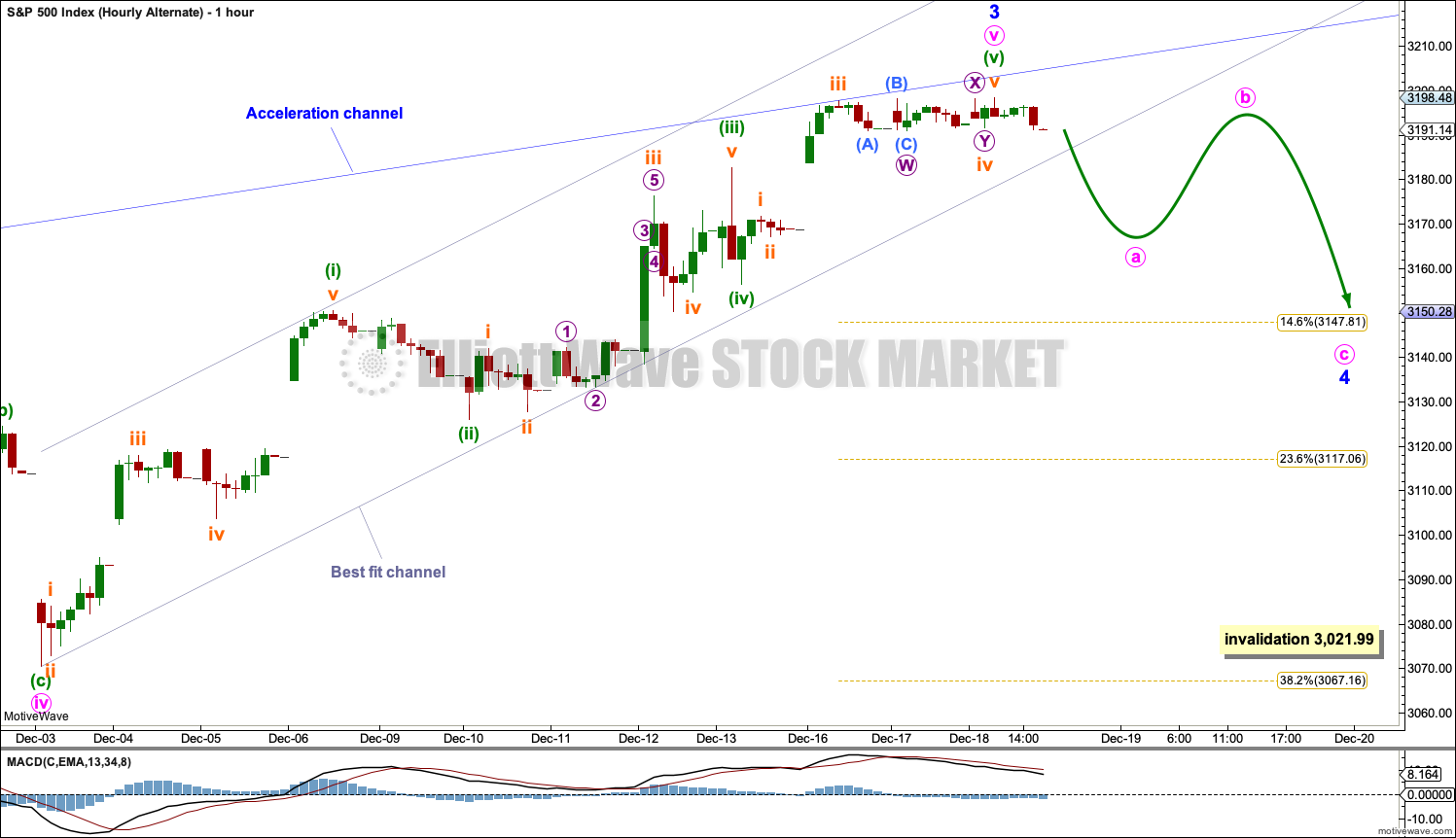
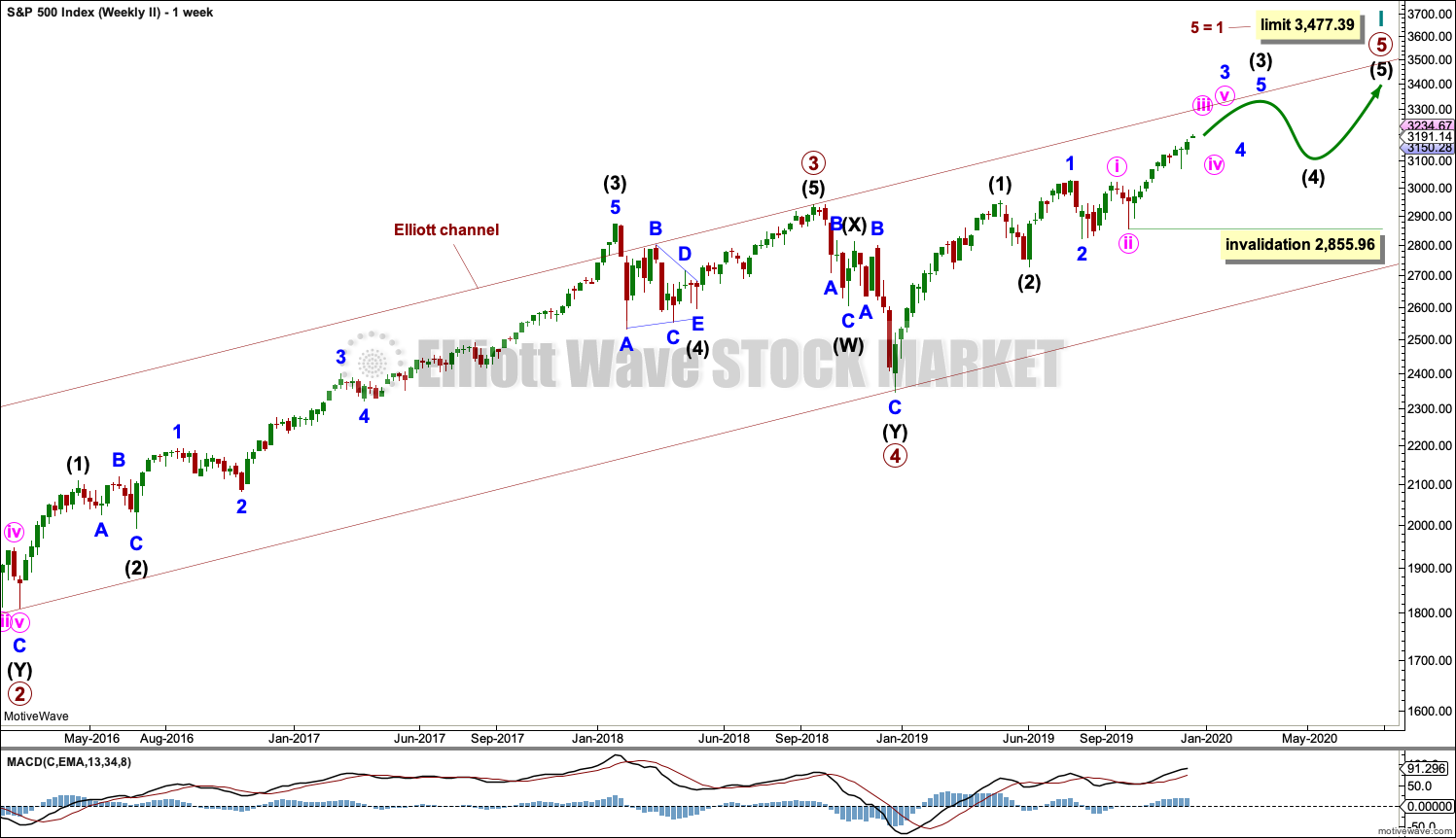
updated hourly chart:
subminuette iv may have been over as a double combination lasting 15 hours to subminuette wave ii at 14 hours. perfect alternation and proportion.
next, minuette (iii) to end, onwards and upwards
In a minor 4 in SPX and other equity averages I would expect gold should go up, or stay relatively flat…but not fall.
The chart seems to suggest that too. A complete corrective structure, a nice double bottom on a key Fibo retrace level, and a break to the upside through a pivot high neckline inside the pivot structure price action. I’ve sold some premium, Jan 17 expiry puts 139/137, and I’ll stop if price breaks under 136.
Kevin,
I had a count where RUT would have moved enough up for it to correct in a 4th wave and stay above 1635… it doesn’t seem to have done that yet..
I am really not sure what RUT will do with SPX in minor 4, will be interesting ?…
What do you have as the latest count?
Here it is, relatively unchanged. I’ll be looking for minor 1 (or is it a minor 3, with what I show as minute b being the minor 1????) to complete now at the 1700 level where I have a Fibonacci projection for swing completion. So yes I think things are well set up for a “coordinated” correction across SPX and RUT starting Real Soon Now.
Here’s a revision positioning the big move up as a minor 3. I had this model as of a few weeks ago…now it’s looking “more right” and the consistency with the SPX model is another supportive indicator. This gives us an invalidation level at the top of the minor 1 as the minor 4 plays out, too.
Thanks Kevin.
Don’t you think your intermediate should actually be primary.., ie take it down 1 level.
Or you think since Dec-18 low it’s all just Primary 1
Maybe. Honestly, my view is simple: it doesn’t matter, “it’s all relative” unless I’m trying to identify some epic large degree V wave complete, which I’m not anytime soon. But yes, this might be more appropriate a degree up or down. It just too much of a royal pain in the fingers to bother with changing given I’m marking it in ToS (which SUCKS for EW work!). Maybe someday ToS will add some kinds of easy EW labeling support, that would be very nice.
Well that makes sense, yeah i do the same when I am just tracking something for a trade…
Thanks.
EW challenges: For me, distinguishing between 5s and 3s is often difficult.
Ah challenges…
the generic EW challenge as I see it is distinguishing between a 3 wave A-B-C correction complete, vs. waves 1-2-3 of a 5 wave impulse complete. Is this a 4 wave or the start of a new motive wave going “the other way”?
AAPL stalling and showing early signs of a pivot high just under my Fibonacci projection for such a pivot at 283.5 (high is 281.9). I’ve taken a short by selling a Jan 17 call spread at 280/285. If price gets to 282.6 I stop out and lose about $50 per spread. If it stays below that I generally make $220 per spread. Nice win/loss ratio, so it’s just a question of the odds of a win vs. a loss. Now…is this really a pivot high top? We’ll see!!! I could be jumping the gun just a tad…but it also affords me the opportunity to add and get a really nice size position if I’m right and price starts dropping from here.
FYI AAPL is now as large a share of the SPX as the ENTIRE energy sector…. heavy
exactly. as falls SPX, so fall AAPL. Minor 4, let’s go! Still may be a few days though. Similar story in AMD eh? I’m keeping my eye on that one. Also BLUE might be a great short soon. I’ve taken a very small short in PEP already as a pilot position, and in IYT. I might be early on these though…
“If this analysis is wrong in the short term, expect any surprises to be to the upside.”
This statement by Lara has proven true once again in this bull market.
A question for members:
What are some of the common complaints of Elliott wave that you have come across?
I have four so far:
1. EW describes what has happened, not what will happen next.
2. If you have 10 Ellioticians in a room you will have 10 different EW counts; EW is subjective.
3. EW is difficult to learn.
4. Elliott wave alternate wave counts, one bull and one bear, are useless because the analyst is putting a bet either way.
Any others members have seen out there in the wild?
It doesn’t matter what happens, there’s always an EW model for it. Which “proves” EW predicts nothing.
One of the statements missing is ” In Elliott , If this happens , then that will happen ” Other words , Once a rule is broken , the count becomes something different . Some times those are larger swings . I like the fact your analysis combines regular technical analysis with Elliott for a best probability scenario .
The funniest one I’ve heard is “You can have 3 main counts with 12 different alternates, and each of those alternates has 5 different alternates!”
LOL 🙂
Another complaint heard:
EW is great for short term moves in the market. But for longer term (weekly and monthly), it is useless.”
Of course, I disagree with this statement. In fact, I am of the persuasion that EW works better for the longer term view / investing. This is where adding classical TA helps the most as well.
Another one –
EW can’t be used for day trading.
The most general complaint I hear is “it’s too subjective”.
Thank you very much for the feedback guys. That’s really helpful for me.
The SPX options skew has zoomed quite high (puts are way more expensive than calls), which indicates larger than usual down side move hedging by big money. That state can persist for quite awhile; it’s not an immediate indicator, but a definite heads up. There’s the divergence in Transports with it breaking down over the last week or two, including today (driven by the FDX result). Now I see the hourly is modeling the minor 3 possibly completing even on Friday; that would be according to Hoyle, with price up against the expected move level from Monday and Friday being quarterly options expiration; the big money maximizes when the week closes on one of the two expected move prices, and the market is often manipulated exactly to “there”. But again, there are divergences in the market, such as AMZN not participating in this rally, some semi’s showing “early” signs of weakness now, and the like. That minor 4 initiation is close at hand now.
BTC-USD quick update:
Daily chart:
Price is within the rather wide target zone. The structure looks incomplete. I expect more downwards movement short term before BTC has found its low.
Daily TA chart:
BTC likes to form sharp bottoms. They often exhibit a bullish candlestick reversal pattern. I’ll look for a bullish reversal pattern to form soon. It may now be sooner rather than later as there is developing bullish divergence between both of price and RSI and On Balance Volume… however this bullish divergence occasionally disappears and price continues lower. It’s not completely reliable.
Thanks Lara.
I think you are missing yesterday’s data, it made a new low around 6400 and shot up $1000 to 7400
Yeah, when the session is incomplete then Yahoo don’t give the data. Looking at that today
Thanks Lara
This model is quite consistent with another I just saw this morning (in a public video). Calling for a likely pivot low around the 5000 area. Low expected early Jan, perhaps on/around the 7th. I’m suspicious it’ll be a little later, and it will be aligned with the SPX minor 4 low. Both may then take off upward in unison sometime mid Jan. There’s a lot of general correlation between these two markets. Let’s see.
How do you recommend trading Bitcoin (i.e. is there an ETF or trust that you like or do you actually buy BTC through an exchange, like Kraken?) Thanks!
I trade it using GBTC, which is an exchanged traded bitcoin fund. It’s fine for TRADING, but not for “investing in bitcoin”. For every $1 in GBTC you only hold something like $0.16 of actual coin. But it trades in near perfect synchrony, i.e., a 2% bitcoin move in a 2% move in GBTC, so it works just fine for my purposes.
I’ve simply bought some BTC. I’m using an Exodus wallet and a Trezor cold storage device for safety. I’ll put that away and leave it be for a few years.
Let me get comfortable here…